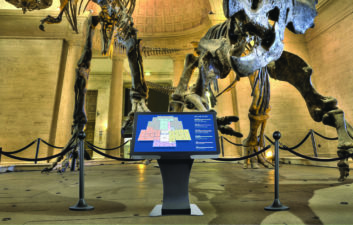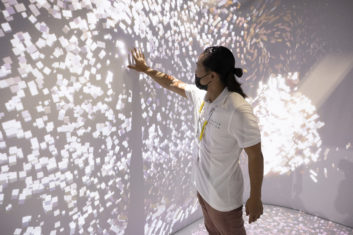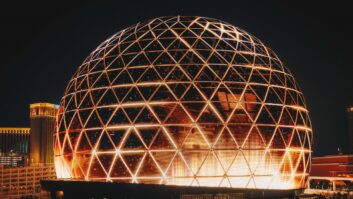The lights went out, the wave machines were switched off, and the rollercoasters ground to a halt. Just like every other public-facing attraction, theme parks were overwhelmingly brought to a standstill when Covid-19 struck in spring 2020. Unlike some other types of visitor attraction, they were also largely unable to reopen amid successive lockdowns, meaning that it’s only in the last month or two that many have been in a position to properly welcome visitors again.
But despite the extended layoff, there are signs that theme parks could recover more quickly than some other sectors. Obviously coming out of a very flat period of activity will be a factor here – but so will the desire for fun and excitement after so many months indoors. The fact that these attractions also tend to have a multi-generational appeal will also contribute to their resurgence.
 The positive outlook is confirmed by the Business Research Report’s Amusement Parks Global Market Report, which was published in April 2021. Having experienced a slight decline prior to the pandemic, the market is expected to benefit from a compound annual growth rate of 11.5%, to reach a total sector value of $89bn by 2025.
The positive outlook is confirmed by the Business Research Report’s Amusement Parks Global Market Report, which was published in April 2021. Having experienced a slight decline prior to the pandemic, the market is expected to benefit from a compound annual growth rate of 11.5%, to reach a total sector value of $89bn by 2025.
With such a strong forecast, there is plenty of reason for theme parks to be reviewing and upgrade their AV specifications. Repeat business is a big part of this sector’s success, and providing high-quality sound, light and video will certainly help in this regard. Increasingly, technologies such as projection mapping and augmented reality are also being incorporated into major attractions. And while some operators may be limited – at least initially – in what they can invest after such a long period of little or no revenue, there is a general expectation among vendors that this market could soon be buoyant once again.
GOOD HEALTH
Most vendors point to a market that was in relatively good health before the onset of the pandemic, with many pointing to a receptiveness to new technologies as a way to differentiate themselves from their competitors.
“Activity levels pre-pandemic were encouragingly positive,” says Joe Graziano, director of sales entertainment EMEA at AV solutions and display products company Christie. “Visitor attractions were showing encouraging signs of investment help to differentiate themselves from the many other entertainment-based environments.”
Yannick Kohn is founder & CEO of media server solutions company Modulo Pi. “From our point of view, the theme parks market was pretty dynamic before the pandemic,” he says. “We had a regular flow of projects made of attractions upgrades or brand new attractions and shows. Moreover, some successful parks – such as the Puy du Fou – are going international, which has resulted in additional installations. In terms of territories, the demand in China has been growing rapidly and did not seem to be affected by the pandemic.”
Tom Fenton – senior business development manager EMEA at AV solutions provider Peerless-AV – indicates that some projects were able to continue during the period of the global crisis. “In terms of how Covid-19 has impacted installation projects, it has not, broadly speaking, rendered projects altogether impossible to complete,” he says.”However, it has slowed them down with travel restrictions impeding engineers getting to site and with supply chain disruption. In some cases, it’s been seen as a great time for integrators as they’ve been able to have full access to sites without other trades and guests on the site.”
VISUAL STIMULUS
Whilst it should come as little surprise that theme parks have continued to place a great emphasis on visual technology – including high-resolution projectors and displays as part of attractions, and digital signage for general visitor information and wayfinding – demand for high-end audio solutions was also on the rise pre-pandemic.
Sami Mäkinen, AV business manager for Genelec, remarks: “Our focus on high quality in audio, green values, long-lasting products and value for money over the long-term is seen as a great advantage by our customers when designing these kinds of projects. The demand for these points has definitely been increasing.”
 Given pre-pandemic activity levels and the expectation that the market could pick up fairly quickly this year, there is an optimism that new AV projects will not be in short supply before long. In the short-term, though, it’s probable that makers of digital signage and other communications solutions will register the greatest uptick as operators enhance their capacity to convey ongoing – and changing – messages about social distancing and other Covid-related precautions.
Given pre-pandemic activity levels and the expectation that the market could pick up fairly quickly this year, there is an optimism that new AV projects will not be in short supply before long. In the short-term, though, it’s probable that makers of digital signage and other communications solutions will register the greatest uptick as operators enhance their capacity to convey ongoing – and changing – messages about social distancing and other Covid-related precautions.
Jeff Hastings is CEO of BrightSign, which designs media players and provides software and cloud networking solutions for digital signage. Noting that theme parks could be “pretty sparse” on information display technology in the past, he says there has definitely been an increased awareness of “the need for more information [to be readily available on site], whether it’s about social distancing, the need to wear your mask, or other requirements.”
Where once some sites might have relied on print-based messaging, the evolving requirements mean that that is often “not really applicable or sustainable now. So what we see are more people putting in more digital signage systems with more information throughout the parks to keep people informed with regard to the regulatory requirements.”
Dean Tsai, head of LED display and projector business unit at ViewSonic, also notes the impact of the pandemic on display technology needs. “Different levels of social distancing [have been] adopted worldwide and new business styles are evolving accordingly,” he says, before highlighting two primary trends among operators – those seeking larger displays in accordance with social distancing rules, and those taking the opportunity to implement interactive solutions, possibly for the first time.
Of the former, says Tsai: “We find increasing demand for the reduction of physical contact, [which is leading] some operators to choose to relocate their events to larger venues or outdoor [spaces].” Accordingly, the company has been enjoying success with products such as the ViewSonic All-in-One LED Display – which offers sizes up to 216in as well as vibrant colours with full HD resolution and high brightness – and its projectors, many of which can “project an image up to 300in in a single projection, providing immersive cinema-like experiences”.
At the same time, Tsai continues, there are also theme park owners who have acknowledged first time opportunities for them to adopt technologies – allowing them to “create vivid immersive experiences, work remotely, connect sensors for better usage, minimise physical touch whilst keeping human interaction, and reduce the usage of woodworking, backdrop and printing materials [in order to] minimise physical interaction”.
Fenton, meanwhile, points to a continuation of operators’ desire to use technology in order to engage with customers meaningfully throughout their visit: “If we look at outdoor over the past few years especially, the demand has been high to meet customer objectives to have as many touchpoints with each visitor as possible. [This entails] engaging with them at every stage of their experience, from entrance through to exit, and providing all manner of content such as venue information, wayfinding, advertising and safety procedures.”
BRIGHT FUTURE
As in other areas such as corporate and large public facilities, visual technology in theme parks has been partly defined by the shift towards higher brightness and higher resolution products. Mark Wadsworth, vice-president of global marketing at Digital Projection, is not alone in remarking that it “has been a bit of an arms race” to get “brighter and brighter, and higher resolution too”. But now the feeling in the industry, he says, is that “it’s all well and good to do that, but the [projector solutions] shouldn’t become so large that some mounting requirements – for instance, in a dark ride – become impractical”.
 With these kind of concerns in mind, Digital Projection has evolved the Satellite Modular Laser System (MLS), which is designed to offer a number of simple “building blocks” that allow users to address applications ranging from single projector installs to complex, multi-channel domes, caves and simulators. Of particular note is the separation of the compact and light-weight projector from the light source, with the two connected by fibre optic cables up to 100m in length, thereby offering the installer many more options, especially, says Wadsworth, where “space and access are restricted”.
With these kind of concerns in mind, Digital Projection has evolved the Satellite Modular Laser System (MLS), which is designed to offer a number of simple “building blocks” that allow users to address applications ranging from single projector installs to complex, multi-channel domes, caves and simulators. Of particular note is the separation of the compact and light-weight projector from the light source, with the two connected by fibre optic cables up to 100m in length, thereby offering the installer many more options, especially, says Wadsworth, where “space and access are restricted”.
There are certainly settings in theme parks and visitor attractions, he continues, “where you cannot necessarily go in and rig a 300kg projector up there”. But having a system of smaller shoebox-sized projector heads is “more straightforward and can be much more suitable for space-limited environments”.
LASER PRECISION
Several other contributors highlight the growing adoption of laser projection, the benefits of which include a lifespan of around 20,000 hours, little or no maintenance expense, stability and precision colour accuracy, and instant on/off. Greater power efficiency and other green benefits also mean that laser solutions are chiming with operators keen to reduce their environmental impact.
Graziano remarks: “The drive and speed of change towards laser technology has been the biggest change to customer expectations. Many users now demand laser illumination over lamp technology in order to take advantage of the lower consumable costs in attraction spaces owing to the considerable length of time that they are in use. This has in turn led to the further development of improved resolution – UHD and native 4K are now far more commonly requested in the attractions and immersive spaces than in recent years.”
Looking ahead, Fenton says that Christie recognises the trend towards RGB pure laser, Rec. 2020 colour space projection for live events, theme parks and attractions. “This will continue as the technology gets brighter and quieter, [and as] form factors and costs are reduced,” he says. “Additionally, we see a greater role for sophisticated software tools in controlling and aligning projectors, therefore reducing set-up and operational time in-between shows/performances or at the start of the day, managing richer, higher resolution media. We also see a growing trend towards signal management and the ease of using protocols like SDVoE to distribute video over Ethernet.”
IMMERSIVE EXPERIENCES
Across the board, there is an expectation that operators will continue to explore immersiveness, sometimes using existing technologies to shape new types of experience. For example, Fenton alludes to the continued potential of Direct View LED in developing “immersive and memorable” attractions.
“In a theme park, for example, LED could be used where traditional projection would once have been used,” he says. “An example would be the creation of a visual tunnel on a ride where content surrounds the audience, changing and storytelling as the ride unfolds. Interactive software can also be used with LED displays to incorporate games and enhanced shared learning experiences.” More engagement with visitors, such as that provided by extended displays, could also have revenue benefits: “For advertisers this means more time and contact points with audiences.”
 For Modulo Pi, Kohn points to increasing interest in “immersive interactive environments”, but tempers that with an awareness that budgetary constraints need to be considered too. “For this reason, the demand keeps on being shared between cost-effective and more high-end solutions, [with] reliability remaining key for any project.”
For Modulo Pi, Kohn points to increasing interest in “immersive interactive environments”, but tempers that with an awareness that budgetary constraints need to be considered too. “For this reason, the demand keeps on being shared between cost-effective and more high-end solutions, [with] reliability remaining key for any project.”
Nonetheless, he expects the trend for experiences featuring both tracking and interactivity to continue. “The tracking might be asked for the audience during pre-shows, and that is a good way to transform frustrating queue lines into memorable interactive experiences. Parks are also interested in bridges allowing personalised and augmented experiences using mobile phones.”
Kohn indicates that a busy year is in store: “We are glad to see our media servers involved in new attractions due to open in 2022 – among them one immersive attraction with a 360-degree LED wall surrounding the audience will be powered by the Modulo Player [media server].”
INCREASED CONVERGENCE
As the practical deployment of technologies such as virtual reality and augmented reality becomes more feasible, we should also expect to see more convergence between the digital and physical domains. Kelly Eagle, client services director at Pixel Artworks, comments: “AR is a trend that’s seen greater adoption by the general public and businesses over the past 18 months, and will continue to be used to enhance experiences moving forward. It can be deployed at scale but provides entertainment and a personalised experience.
“The blurring lines of convergence is another trend that continues to grow, making a seamless experience from the physical to the digital and vice versa,” she adds. “Artist exhibitions such as the Van Gogh projection mapping experience [Van Gogh Alive, currently in London] have only started scratching the surface of what is possible. This will certainly play out in future theme parks and visitor attractions as they are the ultimate experience destination and need to do more to keep this title.”
Hans Christian Stucken – global marketing advisor at projection screens, media & show control solutions provider AV Stumpfl – also anticipates continued adoption of projection mapping while emphasising the growing need for interconnectivity and compatibility.
“Using a particular building’s surface as an additional canvas for storytelling has become a standard tool whilst it was still comparatively rare ten years ago,” he says. “While the creative possibilities for custom programmed control scenarios seem endless, usability, interconnectivity and system compatibility are becoming ever more important. Since so many kinds of different creative visions for theme parks can now be made into a tangible and exciting reality, the ways in which these can be realised more easily is becoming more important. This trend is one of the reasons why we decided to make our new PIXERA control software system an integral part of our general PIXERA media server interface, so that users can interact more directly with our PIXERA API.”
AUDIO AIMS
Although the changes on the audio side may be less all-pervasive, two general trends – for more multi-channel installations and IP-based audio – will continue to make their mark. With the latter, ease of deployment remains a key requirement, as Genelec’s Mäkinen indicates: “We introduced an innovative IP audio-based loudspeaker system, Smart IP, at the end of 2019. The Smart IP series is a ‘one cable’ solution with just a single CAT cable which carries [Power-over-Ethernet], the audio signal and control, managed via our Smart IP Manager software. It is a huge benefit for installers and very cost-effective to install into new buildings [as well as old] renovated buildings since there is no need for any special cabling. The portfolio consists of two loudspeaker model so far, 4420A and 4430A.”

More generally, he expects the trend towards “higher-end products” – in which sound quality is prioritised along with aesthetics, lifespan and sustainability – to accelerate as part of a focus on delivering more impactful visitor attractions. “Better quality audio and the whole experience around that gives much stronger experience to the visitor in all applications. It does not matter whether the played material is music or speech or simply sound effects – the product should be able to deliver the same high quality experience for all applications.”
GOING GREEN
Among its many side-effects, the pandemic has occasioned a more profound awareness of climate change and the speed at which it is now proceeding. Consequently, visitor attractions of all kinds are bound to make carbon reduction an important aspect of their operational and marketing strategies from now on, and will be looking to prioritise technologies that complement this vision. Despite this, the sector’s competitive focus on giving visitors ‘more bang for their buck’ isn’t about to dissipate.
Kelly concludes: “As ticket prices increase, people expect more from the experience and companies need to convert new consumers to loyal customers while increasing footfall and revenue. But with creative thinking and execution, it can be done.”







